Looking for hidden treasures at the back end of the year
Friday, November 28, 2014
After several recent mammouth News iIems, the garden is
slowing down now so this month's news is at last much shorter which
will come as a great relief! In a mild but very changeable month
there was still a surprising amount to admire, with roses and
salvias in particular continuing to delight.
This lovely bouqet picked from the garden and tunnels on
23 November included rosa "Blush Noisette", chrysanthemum "Emperor
of China", a tall kalimeris ( see more details below) and
salvia leucanthe "Santa Barbara"

Most of the daisy tribe had had enough of the often heavy rain,
with just a few brave flowers continuing to put on a show, none
better than dahlia merckii. Just when I thought th daisy show was
over a very late tall kalimeris came into flower in the second week
of the month, name long since lost - isn't that always the way?? I
wish I was more disciplined with my records! With many of the star
performers now finished it is time for some of the quiet unsung
heroes to come forward, late autumn being their brief moments of
stardom.
Weather
A typical November in many ways with regular heavy rain, gales,
thunderstorms, some sunny days and generally continuing mild both
day and night. Until 24th when we had our first frost since 19
April, one of the longest frost free periods I can remember in
nearly 40 years of living here. It took some getting used to and
had me searching for the thermals and the essntial woolly hat!
Max 15C on the first of the month, Min -4C on 24th
and 25th. Daytime temperatures were cold reaching just 5C
with brilliantlly clear skies and at dusk a beautiful
crescent moon which rose and set over the tall hill to the south
west in the space of half an hour. Just time to get the
camera.!
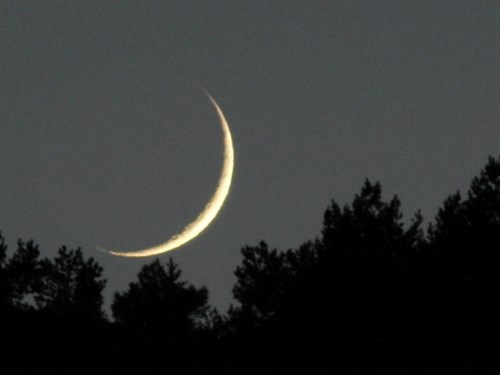
Garden update
Tidying up was the main task this month with fallen leaves top
of the agenda. It seemed a less arduous task this year as most of
the trees seemed to shed their leaves at about the same time and
was quickly completed thanks to the loan of a leaf blower from our
friend Rob the Lawn Guru. All the leaves are blown into the flower
borders to enrich the soil and provide some winter protection.
The latest colouring acer in the gardens is a. palmatum
"Orange Dream" It colours to a deep yellow/orange in just a few
days then drops its leaves. Good to have some sunshine to show it
off to best effect.

A 50th birthday gift from friends Sylvia and Tony, this
liquidamber is a reliable source of late colour into December.
Sadly 2 days after this picure was taken, in a fierce gale
one of the 2 main leaders was snapped. Fortunately the main shape
of the tree now 20 feet tall has not been altered. It is always
good to have special memories of friends or happy events in our
gardens.
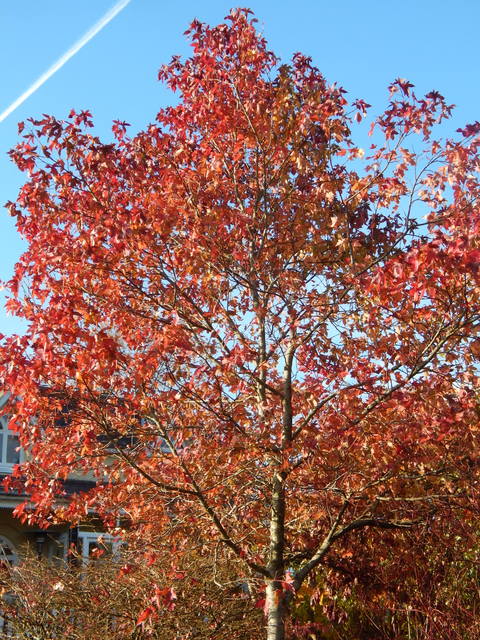
I continued to mow the lawns until the frosts came but I
think it is now safe to conclude that lawn mowing is
officially competed for another year.

With the forecast of frost I dug up many tender plants bedded
out for summer to overwinter in the tunnels, having already
successfully struck cuttings. during October. On fine days it was
good to be able to work on the borders, thinning overgrown clumps,
cutting back some trees and shrubs. The Picket Fence border
near the house,is the only border of the 17 that I cut back
now, all the others wait until February.
When cut back it affords a better view to the log store
under the verandah, a winter attraction for passing traffic for
which we are almost as well known locally as we are for the flower
borders in summer!!

I also started to cut off this years leaves from the hellebores,
quite a task with well over 200 throughout the gardens and many
more in pots in the nursery. I have 4 pages of reporters notebook
filled with winter tasks to complete so it is good to have got
ahead in some areas. I am a firm believer that using the winter
months in this way is an essential element of a successful new
gardening year.
In tidying up the borders I found several areas which had
started to look tired or underused and having cleared them, they
were underplanted with spring bulbs for immediate impact next year
to which summer plantings will be added later.
What's looking good?
The hidden treasures! They may not be show stoppers, but perhaps
thiis doesn't do them justice because at this time of year we are
grateful for anything fresh or new to squeeze every last ounce of
interest out of the garden year before it finally fades into
memory.
Seedheads of selinum wallichianum considered by many to
be the "Queen of Umbellifers"
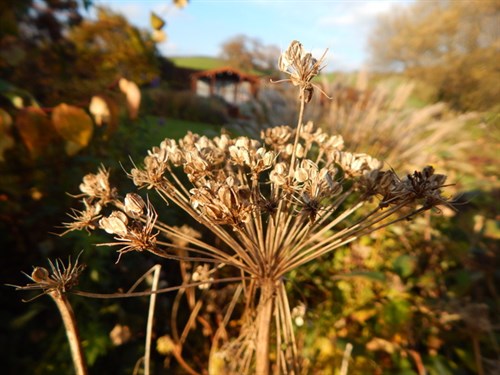
Many clematis have valuable seedheads in a variety of
forms. This candy floss concoction belongs to clematis rehderiana,
late flowering with cowslip scented pale lemon flowers. A vigorous
grower to 20 feet.
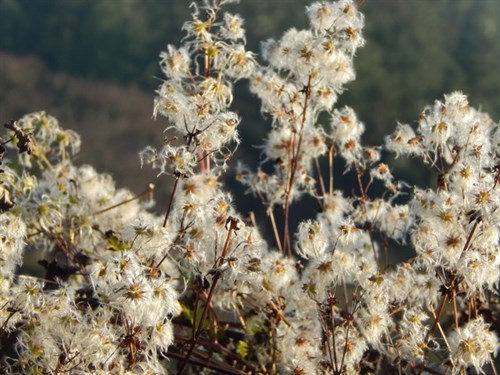
Needing no introduction the seed heads of honesty (
lunaria annua) stay in good condition for most of the
winter

One of the many seed pods on cardiocrinum giganteum
plants that I featured in a special June news item. Long pods to 3
inches packed withindividual seeds needing to be sown straight away
on their 6 year journey to one of the most magnificent flowers you
will ever see or smell.
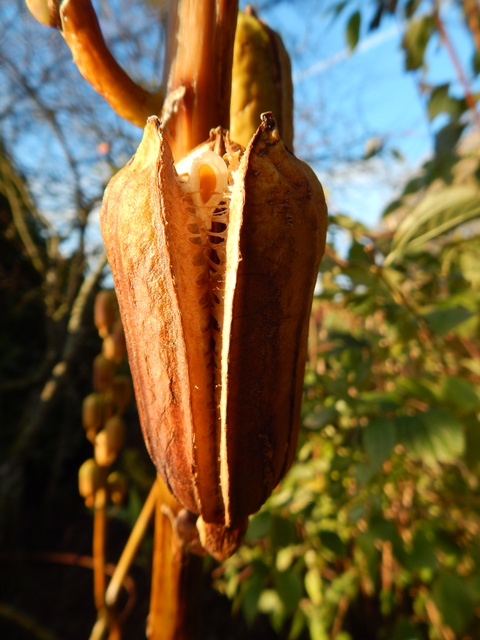
And surely the best and most long lasting seed
heads of all are those of tall miscanthus here teamed up with that
tall late kalimeris I may have mentioned before! And can't you see
why? I a;lways think that blue with orange or tawny brown is such a
winning colour combination

We tend to think of the saxifrage family as comprising plants of
alpine origin, spring flowering with silver rosettes, but it is a
more diverse family than that including superb autumn flowering
Japanese saxifraga fortuneii in a wide range of cultivars and other
genus too.
Short, dainty and excellent in humus rich soil in part
shade saxifraga cortusifolia it has reddish veined leaves and
elegant elongated flowers. Really choice.
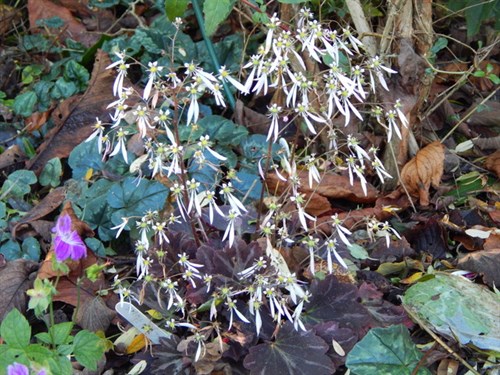
The "Marmite" plants, heucheras, in an ever growing range
of gaudy coloured foliage, divide opinion and in the past I must
confess to having been rather sniffy about them especially having
seen them displayed by nurseries "en masse" at the large flower
shows. However I remembered something that Gertrude Jekyll said in
one of her books when she was deriding Victorian flower schemes
based solely on bedding plants. She opined that there was nothing
wrong with the individual plants it was just how they were put
together. So I looked at heucheras again. They are generally easy
to place in the garden being tolerant of a wide range of
conditions: I have them in full sun and partial shade, using their
leaf colour to provide a long season of interest (In a mild winter
staying "wintergreen") and to complement their border companions.
For me the most attractive feature is their graceful flowers
produced in succession from mid summer to autumn - a feature not as
widely appreciated as it should be. And as for choice of
cultivars just Google "heucheras" to see what I mean!
This greem marbled leaved heuchera with good repeats of
red flowers on long upright stems is an elegant addition to
the borders but it came to without a name. The nearest I can find
to it is a form called "Lipstick"
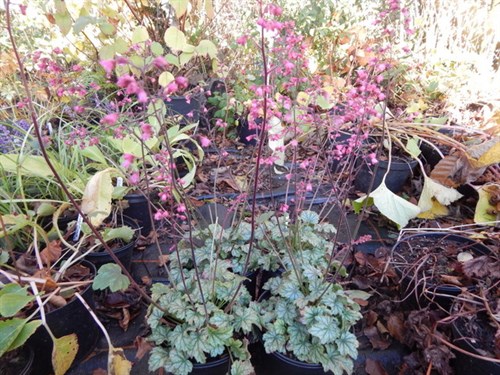
Two dark leaved heucheras, on the left is "Blondie" and
on the right is "Binoche" with near black leaves in full sun. In
between them is heucherella "Alabama Sunrise"

If they still don't turn you on perhaps heucherallas might be
more to to your taste, an interesting cross between heuchera and
tiarella, with palmate, patterned leaves and superb flowers,
which look more natural than many of the more dumpy forms of
heucheras. The breeders especially in the USA seem to be
concentrating more and more on new hecherella crosses for which I
predict a bright future and less money in our pockets!
A closer look at "Alabama Sunrise" which in summer is a
much more golden colour with incised red leaf veins.

Other hidden treasures are revealed in the following gallery of
pictures
Fuchsia "Hawkshead" glowing in a shady spot.
Several other varieties of fuchsia elsewhere in the gardens also
kept going well unbtil the frots arrived

Liriope muscari is an underrated and undervalued very
late flowering perennial for difficult places like dry shade.
Spikes of blue flowers (and a few white flowered and
variegated forms) until December in a mild autumn like this
one.
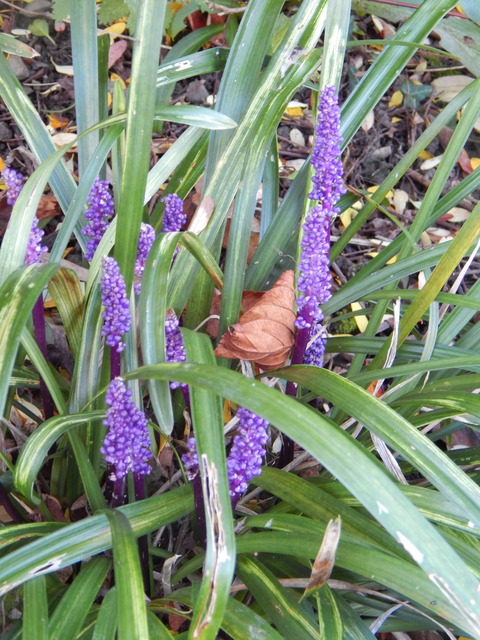
In the benign environment of the large tunnel
there is plenty still to admire. In the case of the latest
flowering form of the hedychiums I grow "Lunar Moth"
has 12 flowering spikes which will open slowly over 4 - 6
weeks. On milder evenings just a few flowers will fill the air with
a heady perfume
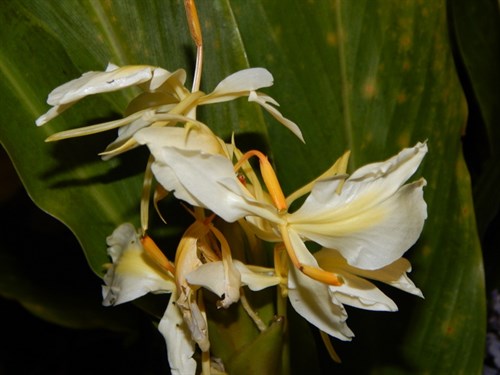
Cestrum elegans is a tall tender shrub with shiny green
leaves and panicles of red flowers almost year round. I cut it back
to a couple of feet in the new year to keep it in
check.
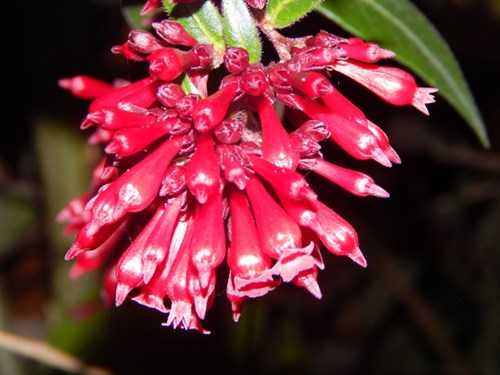
Another plant I owe to Tony and Sylvia is justicia
carnea whcih I have had for many years. Not the original plant but
successions of cuttings which strike easily and in just a few
months flowers will begin to appear. Coming from warmer parts of
South America it is of course tender.
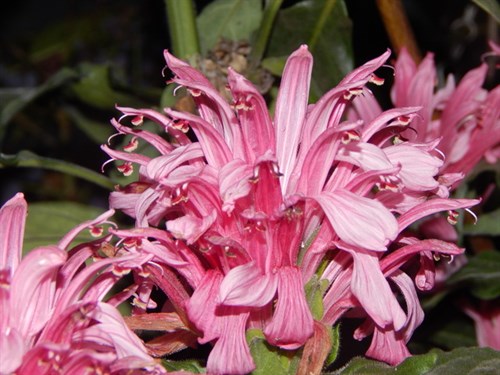
Wildlife and countryside
In the countryside there are many indicators of autumn - the
leaves turning colour, the departure of the swallows, the
shortening day lengths, whispy woodsmoke in the valley and the
first frosts are events that come readily to mind. For me there are
others too. "Murmurations" of starlings, the arrival of redwings
and fieldfares devouring all the ripe berries is special but best
of all perhaps after dark is the massed hooting of owls in the
trees around the Lodge and the cries of mating foxes in the nearby
woodland. The true calls of the wild. The fieldfares and redwings
still haven't arrived yet but otherwise it is business as
usual.
Yellow autumn colour on a wych elm at the bottom of the
Paddock Garden. A sucker from a parent tree 10 yards away which
succumbed to Dutch elm disease in the early 1980's, it has done
well to survive but often at around 30 years old they become prone
to the disease again. There are however a few fairly mature trees
in the surrounding countryside.
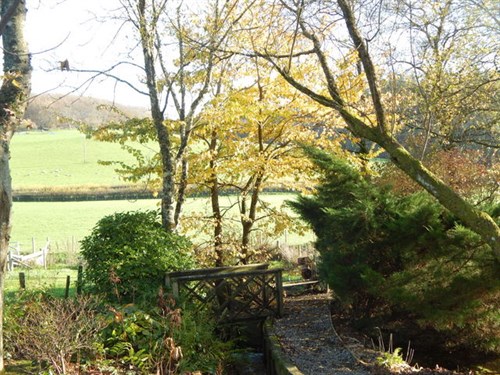
Another autumn feature in our part of Wales is the annual
trimming of the hedges around the traditional field patterns.
Although hedge laying is still practised it has largely been
overtaken by mechanical means which if undertaken yearly, keeps the
hedges tight and stock proof, and as an additional bonus is
aesthetically pleasing. All my farmer neighbours take great pride
in their farms and neat hedges contribute to the sense of
wellbeing.
The beech hedge enclosing the gardens is a striking
example of the mechanical hedgecutters art. Gwyn
Williams one of our near neighbours, is a a particularly fine
exponent and one cutting at this time of year keeps the hedge a
manageable size and looking tidy until next autumn.
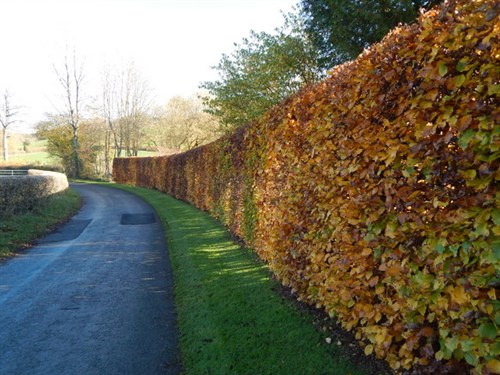
Last month I reported on the great numbers of a native
fern, polypodium cambricum, growing in West Wales. I should have
looked closer to home! On a recent walk tthrough Cilgwyn Woods
across the valley from the Lodge, I found a large oak tree on the
boundary of the wood with polypodiums growing epiphytically all
along one large branch Amazing!

Oh and I nearly forgot - a moorhen on the Paddock Pond - not a
rare waterfowl but not encountered frequentky here. A gentle,
secretive bird.
Visits and visitors
Just 2 talks this month to the Hardy Plant Society in Newcastle
Emlyn and Ferryside Gardening Club, both recipients of my most
requested talk this year, "50 of My Favourite Perennials". We now
have a 2 month break before the next round of talks
begins.
A fine hoar frost on the remaining flowerheads of
kalimeris one of the true unsung heroes of this fine
autumn.

And talking of those of the late autumn I have to
confess to another birthday, all too quickly having come around
again. *7 years young today! (you supply the missing
number!!)
